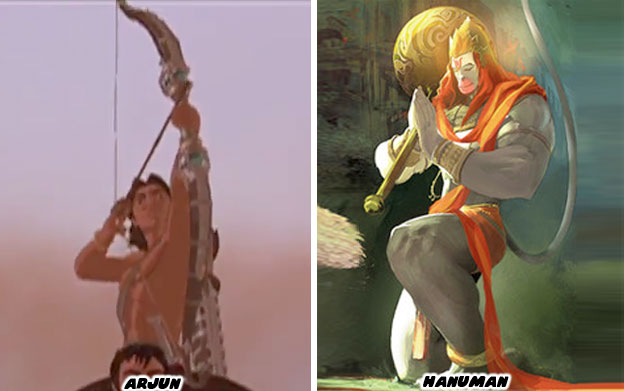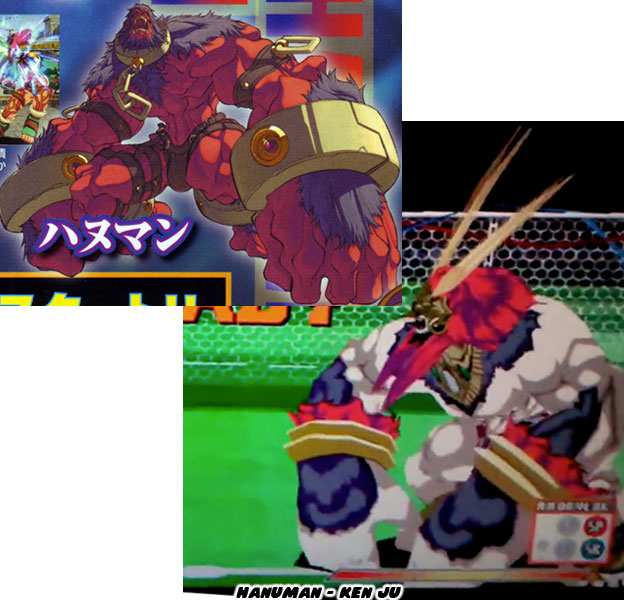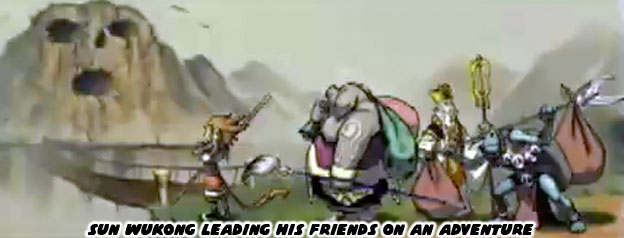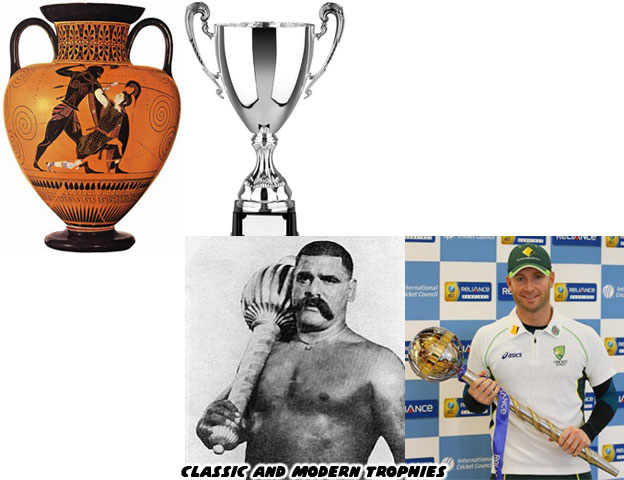In Asian traditions two of the oldest icons were symbols of purity, strength and nobility. Arjun (also written Arjuna) and Hanuman were figures central in Hindu traditions. The gods favored Arjuna and blessed him with weapons and training. He was challenged at every opportunity and tempted to go astray many times. His name could be translated literally as shining or bright. Arjun was a figure whose martial prowess and especially the use of a bow were inspirational. If he had one failing, as most classic heroes tended to do, it was that he was extremely prideful in his abilities. He was so proud that he would squander his gifts from the gods just to prove he was as mighty a warrior as he claimed to be. More often than not these parables were a way to humble the man and remind him that the needed to be humble and honor the gods that favored him. That pattern of pride coming before the fall turned up in both Western and Eastern storytelling traditions. The legend of King Arthur and Beowulf from classic tradition also featured stories of how pride was a dangerous thing.

A contemporary of Arjun was Hanuman. The god creature was actually a vanara, or ape-like man. Hanuman was also blessed with powers and gifts from the gods. He was insanely strong, capable of carrying mountains with one arm, he also had the ability to change his size at will. His favored weapon was a war hammer, sometimes referred to as a mace. Despite his appearance Hanuman was extremely intelligent and well spoken, having memorized all of the holy scriptures and a scholar of nine different languages. Arjun and Hanuman crossed paths and you can imagine that two prideful characters did not get along well. After they had a quarrel they were reminded that they should know better than to waste their talents just to satisfy the foolish notion of pride. A wonderful graphic novel Sundarkaand Triumph of Hanuman explores the myths of the character and shows why even to this day Hanuman is still revered around the world.

There was a fighting game in the works called Ken Ju that actually featured a beast man called Hanuman. He was a large hairy, red-skinned character. He wore chains and shackles and was sort of like Blanka but on steroids. The arcade game was a rare 3D title developed for the Sega Atomiswave cabinet. Sammy designed the title and few copies of the game are known to exist. Above is a look at the alternate costume for Hanuman, in it his skin was white and he wore golden armor and a mask. The alternate look was more in line with the traditional representations of the figure. The adventures of Arjun and Hanuman helped spread the tenants of Hinduism. What was interesting was how the use of mythological characters spread from India to China. Animal gods were celebrated in almost every culture around the world. There were creatures who could think and act like a person while retaining the appearance of an animal. Some of these creatures even had supernatural powers as well.
In Chinese tradition no animal character was better known than Sun Wukong, the Monkey King. He was one of many figures that existed in classic storytelling traditions. As Buddhism spread from India through China a new parable was created. The mischievous Wukong was humbled by Lord Buddha and made to serve as a guide to the Buddhist monk Xuanzang (Tang Sanzang) as penance. The story that featured his adventures would become known as "Journey to the West." Wukong was a mighty figure, he was impossibly strong, could change shape, a master martial artists and could leap countless miles in a single jump when he wasn't riding around on a cloud. He was also a trickster and notorious troublemaker. Yet even with all of his powers he was nothing in comparison to Buddha. This format of humbling mythological characters helped demonstrate that the new religions were the true faiths. I would contend that Sun Wukong was actually a variation of the legend of Hanuman that had reached China before Buddhism. The war hammer of Hanuman was replaced by a magical staff that could also grow impossibly long. As Buddhism spread Journey of the West helped bring in older figures into the fold and keep them relevant to the culture.

The legends of Hanuman and Wukong would persevere and last well into the 21st century. In pop culture the characters would be celebrated in comics, cartoons and even video games like IGS' Oriental Legend series. The long-running Japanese series Dragon Ball was inspired in equal parts by Superman and Journey to the West. The main character Son Goku was mistaken as his reincarnation of Sun Wukong early on in the series. He even had a magical staff and could ride around on a cloud like the classic figure. The manga inspired a generation to read up on the older stories and see what Akira "Dr. Slump" Toriyama used as the basis of his series. Live-action features based on ancient gods were still being produced and the relevancy of these figures was still an important part of society. The legends were still heroic and virtuous and could teach modern audiences a thing or two about doing the right thing. An excellent analysis of the symbolism used in action games can be found on A Buddhists Guide to Asura's Wrath by Art-Eater. The author goes to great lengths to chronicle all of the nuances and details that Capcom had placed in their game.There were also other ways in which classic traditions were observed in modern culture.
In combat sports like boxing, wrestling and mixed martial arts there were rewards given to the victors that resembled ancient artifacts. The belt awarded to prize fighters could be traced back to ancient times, more than two thousand years ago. In different parts of the world combatants, sometimes soldiers on a battlefield, sometimes gladiators would be rewarded the banner or sash of a rival opponent as a victory trophy. In modern times boxers would show that they were champions by wearing a colorful belt with a large buckle at social events. Over time the belts became larger, more ornate and more colorful. The belt signified that they were the absolute best in the world, the literal peacock feathers for the fighting community. There were also trophies that went even further back in time. The Greeks would reward the victors of early sports competitions with jars filled with olive oil. The victor would be crowned with a wreath of olive leaves as well. The wreath was lost to tradition but the cup remained. It would become synonymous with victory and would take many forms and materials over the years but retain its basic shape.

In South Asia the trophy used for wrestling competitions was shaped like a mace. It symbolized the war hammer of Hanuman. The victor of a competition was said to have had the same qualities of the ancient god. Chief among them were honor and strength. Just like the title belts and victory cups the hammers could be made of polished gold or silver and be decorated with precious stones. To this day the belt, cup and mace were still used as symbols for sporting champions. In many fighting games there were characters that were shown with belts or trophies that they had won as well. Symbols became very important to the development of fighting games. The oldest figures from Asian tradition would become the backbone of the most powerful characters in the fighting games developed by both SNK and Capcom. The next blog will look at the most fearsome characters ever created. As always if you enjoyed this blog and would like to sponsor me please visit my Patreon page and consider donating each month, even as little as $1 would help make better blogs and even podcasts!

No comments:
Post a Comment